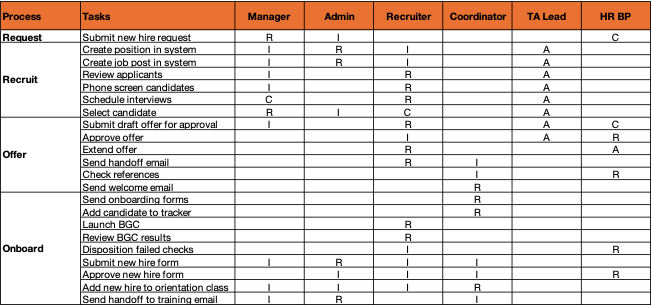From Documentation to Transformation: Unleashing RACI's True Potential
Learn how to leverage your RACI chart to improve efficiency, empower teams, and redesign work that actually works.
Most leaders treat the RACI chart as a necessary evil—a compliance exercise to document who does what. This perspective misses the transformative potential hiding in plain sight.
While RACI charts excel at clarifying current-state responsibilities, their real value emerges when leaders use them as strategic tools for organizational redesign. Forward-thinking executives are discovering that RACI matrices can unlock productivity and motivation.
What is RACI?
For five decades, the RACI framework has served as the standard for mapping roles and responsibilities. The acronym breaks down simply:
Responsible - the role that performs the work. Every task needs exactly one "R"—no more, no less.
Accountable - the person ultimately answerable for the outcome. Only one "A" per task ensures clear ownership.
Consulted - stakeholders who provide input before decisions or task completion. Multiple "C" designations are acceptable when expertise is distributed.
Informed - parties who need updates when decisions are made or work is completed. Like consultation, information flow can involve multiple recipients.
The traditional benefits are well-established:
RACI charts provide clarity by eliminating role confusion and preventing work from falling through cracks.
They ensure accountability by designating clear ownership, creating guardrails against finger-pointing and vague commitments.
They streamline decision-making by separating contributors from decision-makers, preventing bloated consensus-seeking that paralyzes progress.
They also accelerate onboarding by giving new team members immediate visibility into how the work is supposed to happen.
Using RACI to reimagine work
But the real transformation begins when leaders shift from documenting existing processes to imagining better ways of working. Then, RACI charts become diagnostic tools that expose inefficiencies, highlight opportunities for empowerment, and reveal automation potential.
Consider a recent engagement with an HR organization struggling with their hire-to-onboard process. Their RACI chart (a simplified version is shown below) revealed six distinct roles involved in the process.
Combine Roles
Looking at the RACI chart showed 14 hand-offs! Hand-offs are problematic because they increase cycle time and require coordination.
An easy way to identify hand-offs is to focus on the R’s.
If you see a lot of back and forth, ask yourself whether you can combine responsibilities. Consolidating roles not only reduces hand-offs, it also helps to create more engaging work. Employees prefer owning complete outcomes rather than executing fragmented tasks in isolation.
The team decided to consolidate the admin, recruiter, and coordinator role – creating a ‘super-recruiter’ role that would own the process from start to finish.
Empower People
RACI charts also reveal decision-making bottlenecks with surgical precision. Look for patterns where leaders hold "A" or “R” designations for routine operational decisions. These represent empowerment opportunities.
Effective delegation isn't just about pushing decisions down—it's about pushing them to the right level. The person closest to the work and its consequences should own routine decisions. Reserve senior leadership involvement for truly strategic choices that require enterprise-wide perspective.
The team decided to empower the super-recruiter to submit the draft offer and check references- two steps with limited risk. The new process design reduced the number of hand-offs from 14 to 8!
Leverage technology
RACI charts serve as automation roadmaps when viewed through the right lens. Every routine task marked with "R" deserves scrutiny: Could technology handle this more efficiently?
Look at information flow—the "I" designations. Status updates, progress reports, and completion notifications are prime automation candidates. Workflow tools can trigger notifications automatically, eliminating manual communication overhead.
Approval processes marked with "A" also deserve special attention. Routine approvals that follow predictable criteria can often be automated, reserving human oversight for exceptions and edge cases.
When the team analyzed RACI the process, they quickly identified eight tasks that could be performed more efficiently leveraging technology.
How to Get Started
Pick a target: Start with high-impact processes that touch multiple departments or consume significant time. If you do not already have a RACI, create one. If you have one, make sure it is current.
Engage the team: Organize a workshop with process participants to challenge the current state. People support what they help create, and front-line workers often have the best insights into process inefficiencies.
Ask provocative questions: Could we combine these responsibilities? Where are we requiring approval out of habit rather than necessity? What if we eliminated this consultation step? What information could systems provide automatically?
Don't aim for perfection: Redesign incrementally, testing changes with pilot groups before broader rollout. This approach builds confidence while minimizing disruption.
Keep score: Establish a baseline for relevant metrics so you know whether your changes deliver the intended value. Cycle time improvements demonstrate streamlining success. If decisions or task completion accelerate after redesign, you've eliminated genuine bottlenecks. Employee engagement is another critical measure. Engaged employees report higher role clarity and decision-making authority. Survey teams regularly to ensure changes enhance rather than complicate their experience.
The Path Forward
RACI charts will continue documenting organizational reality—but they can do much more. Leaders looking to build more agile, engaging, and efficient organizations, start with a simple question: What would better look like?
Your RACI chart holds the answer to that question. The tools for transformation are already on your shelf—you just need to see them differently.
Our Level Up framework provides a structured approach to help you and your team identify opportunities, build capabilities, and implement changes that make work more productive, valuable, and motivating. From lightweight guidance to comprehensive transformation support, we offer flexible solutions that meet you and your team where you are. To learn more how we can help your team reach the next level of performance, join us for one of our upcoming webinars.








We did utilize RACI a lot during building mobile app for the University.